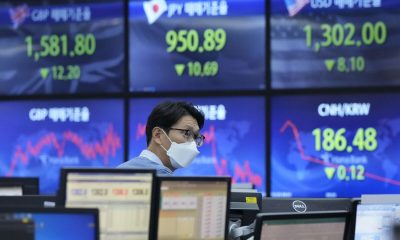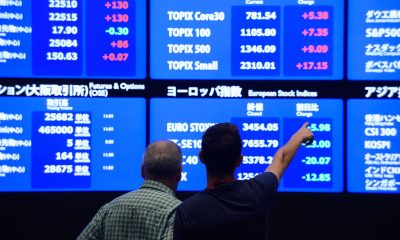Economy
Nikkei clinches fresh three-decade high as BOJ stands pat

Japan’s Nikkei notched a fresh three-decade high and its 10th consecutive weekly gain on Friday, as investors cheered the central bank leaving its ultra-easy policy settings unchanged.
The Bank of Japan (BOJ) kept intact its pledge to “patiently” maintain massive stimulus. The Nikkei closed 0.7% higher at 33,706, having touched a 33-year high in late trade.
Its weekly gain was 4.5% and the 10-week winning streak that propelled the index 22% higher and was the longest in 11 years.
The broader Topix rose 0.3% on Friday and was up 3.4% for the week. The yen weakened slightly and Japanese government bonds rallied a little on the BOJ announcement.
Nomura strategist Naka Matsuzawa said the decision was not a surprise, but further market reaction could hinge on Governor Kazuo Ueda’s press conference remarks that began at 3:30 p.m. JST (0630 GMT).
“Ueda’s style is to signpost leading in to meetings,” he said. “We’re not going to get the surprise policy changes we saw under (his predecessor Haruhiko) Kuroda.”
Financials were the weakest spot in an otherwise positive day as low interest rates and the prospect that they stay low keeps bank lending margins thin.
The wider rally has been driven lately by the yen’s weakness, which flatters exporters’ profits, and money flow from foreign investors, who have been impressed by an official drive to improve Japanese corporate governance and balance sheets.
Canon Inc shares rose 4.9% to their best close in five years, after the cameras-to-scanners conglomerate announced a stock buyback in the latest example of shareholder-friendly cash management.
Shares of rivals Olympus and Nikon also rose 4.5% and 3.8% respectively.
Travel and consumer stocks also performed well.
Japan Airlines shares rose more than 4% to a three-year high. Shares in cosmetics-maker Shiseido rose 5.2%. Top losers included lens-maker Hoya Corp, falling 2.4% and railways operator Tokyu, which concluded a buyback on Tuesday, fell 2.5%.
“The case for Japan remains the growing bottom-up evidence of a change in corporate governance, with the help of pressure from activists, combined with mounting evidence that inflation is back,” said Christopher Wood, global head of equities strategy at Jefferies.
Economy
Russian central bank says it needs months to make sure CPI falling before rate cuts -RBC


© Reuters. Russian Central Bank Governor Elvira Nabiullina attends a news conference in Moscow, Russia June 14, 2019. REUTERS/Shamil Zhumatov/File Photo
MOSCOW (Reuters) – Russia’s central bank will need two to three months to make sure that inflation is steadily declining before taking any decision on interest rate cuts, the bank’s governor Elvira Nabiullina told RBC media on Sunday.
The central bank raised its key interest rate by 100 basis points to 16% earlier in December, hiking for the fifth consecutive meeting in response to stubborn inflation, and suggested that its tightening cycle was nearly over.
Nabiullina said it was not yet clear when exactly the regulator would start cutting rates, however.
“We really need to make sure that inflation is steadily decreasing, that these are not one-off factors that can affect the rate of price growth in a particular month,” she said.
Nabiullina said the bank was taking into account a wide range of indicators but primarily those that “characterize the stability of inflation”.
“This will take two or three months or more – it depends on how much the wide range of indicators that characterize sustainable inflation declines,” she said.
The bank will next convene to set its benchmark rate on Feb. 16.
The governor also said the bank should have started monetary policy tightening earlier than in July, when it embarked on the rate-hiking cycle.
Economy
China identifies second set of projects in $140 billion spending plan


© Reuters. FILE PHOTO: Workers walk past an under-construction area with completed office towers in the background, in Shenzhen’s Qianhai new district, Guangdong province, China August 25, 2023. REUTERS/David Kirton/File Photo
SHANGHAI (Reuters) – China’s top planning body said on Saturday it had identified a second batch of public investment projects, including flood control and disaster relief programmes, under a bond issuance and investment plan announced in October to boost the economy.
With the latest tranche, China has now earmarked more than 800 billion yuan of its 1 trillion yuan ($140 billion) in additional government bond issuance in the fourth quarter, as it focuses on fiscal steps to shore up the flagging economy.
The National Development and Reform Commission (NDRC) said in a statement on Saturday it had identified 9,600 projects with planned investment of more than 560 billion yuan.
China’s economy, the world’s second largest, is struggling to regain its footing post-COVID-19 as policymakers grapple with tepid consumer demand, weak exports, falling foreign investment and a deepening real estate crisis.
The 1 trillion yuan in additional bond issuance will widen China’s 2023 budget deficit ratio to around 3.8 percent from 3 percent, the state-run Xinhua news agency has said.
“Construction of the projects will improve China’s flood control system, emergency response mechanism and disaster relief capabilities, and better protect people’s lives and property, so it is very significant,” the NDRC said.
The agency said it will coordinate with other government bodies to make sure that funds are allocated speedily for investment and that high standards of quality are maintained in project construction.
($1 = 7.1315 renminbi)
Economy
Russian central bank says it needs months to make sure CPI falling before rate cuts -RBC


© Reuters. Russian Central Bank Governor Elvira Nabiullina attends a news conference in Moscow, Russia June 14, 2019. REUTERS/Shamil Zhumatov/File Photo
MOSCOW (Reuters) – Russia’s central bank will need two to three months to make sure that inflation is steadily declining before taking any decision on interest rate cuts, the bank’s governor Elvira Nabiullina told RBC media on Sunday.
The central bank raised its key interest rate by 100 basis points to 16% earlier in December, hiking for the fifth consecutive meeting in response to stubborn inflation, and suggested that its tightening cycle was nearly over.
Nabiullina said it was not yet clear when exactly the regulator would start cutting rates, however.
“We really need to make sure that inflation is steadily decreasing, that these are not one-off factors that can affect the rate of price growth in a particular month,” she said.
Nabiullina said the bank was taking into account a wide range of indicators but primarily those that “characterize the stability of inflation”.
“This will take two or three months or more – it depends on how much the wide range of indicators that characterize sustainable inflation declines,” she said.
The bank will next convene to set its benchmark rate on Feb. 16.
The governor also said the bank should have started monetary policy tightening earlier than in July, when it embarked on the rate-hiking cycle.

 Forex3 years ago
Forex3 years agoForex Today: the dollar is gaining strength amid gloomy sentiment at the start of the Fed’s week

 Forex3 years ago
Forex3 years agoUnbiased review of Pocket Option broker

 Forex3 years ago
Forex3 years agoDollar to pound sterling exchange rate today: Pound plummeted to its lowest since 1985

 Forex3 years ago
Forex3 years agoHow is the Australian dollar doing today?

 Cryptocurrency3 years ago
Cryptocurrency3 years agoWhat happened in the crypto market – current events today

 World3 years ago
World3 years agoWhy are modern video games an art form?

 Commodities3 years ago
Commodities3 years agoCopper continues to fall in price on expectations of lower demand in China

 Economy3 years ago
Economy3 years agoCrude oil tankers double in price due to EU anti-Russian sanctions

































